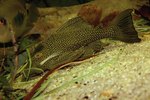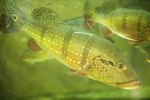
If you're baffled by a mysterious white ooze suddenly growing in your aquarium, you're not alone. Saltwater aquarium owners can experience white slime. While it is harmful to your tank and its inhabitants, you can correct the problem and get the aquatic ecosystem back in balance.
Where Mysterious White Slime Comes From
The white slime sometimes found in aquariums is a metabolic exudate produced by an airborne bacteria known as Alcaligenes faecalis that can grow rapidly in the presence of of alcohol or high amounts of volatile organic compounds and phthalates. This bacteria, under certain conditions, can multiply and spread. The slime, white at first, can turn yellow and eventually brown as it accrues particles and waste from the tank.
Effects of Slime on Aquarium Life
The slime will grow thicker and eventually coat everything in the tank if left untreated. It will kill off the coral two ways: with its acidic composition and by choking off oxygen. The slime is an aerobic heterotroph, which means it thrives off free oxygen and will deplete the oxygen levels of the take, eventually causing the fish to die as well.
External Factors and Causes
Alcaligenes faecalis, the bacteria responsible for the white slime, can thrive in conditions where volatile organic compounds, or VOCs, and phthalates are present in high levels. Possible factors that increase VOCs can be air deodorizers, freshening systems, commercial carpet cleaning services, smoke and the use of the sterilizing instruments such as chemi-claves and other alcohol-based cleaners.
Eliminate Slime and Begin Recovery
The first step to recovery of the tank is to eradicate all known sources of phthalates in the environment. Remove air deodorizing and freshening systems as well as sprays that may contain harmful chemicals. Next, talk with your local aquatic store expert to obtain heterotrophic bacteria that will contend with the slime-producing bacteria for food. Also talk to the aquatic expert to find a solution for revitalizing old tank water and keeping it clear and odor-free. Use this solution every other day for seven to 10 days, using a dose of 5 milliliters per 10 gallons or as otherwise instructed.
Finishing Up Treatment and Routine Maintenance
Talk to your local aquatic store expert to find an aquarium cleaning solution used to dissolve waste and sludge in the tank. This solution will begin breaking up the slime-producing bacteria and will dissolve what is left of the slime. Use the same dosage of 5 milliliters per 10 gallon for two treatments, and then switch to a dosage of 10 milliliters per 5 gallons. Continue to use this aquarium cleaning solution weekly for regular maintenance unless otherwise instructed by an expert.
References
Resources
Photo Credits
-
Ablestock.com/AbleStock.com/Getty Images
Writer Bio
Brian McCracken lives in Portland, Ore., where he writes on pets and animal wildlife as well as a wide array of other topics, ranging from real estate to personal development.




